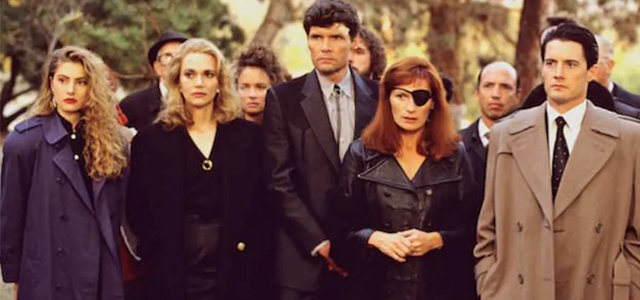Review: Twin Peaks
Starring: Kyle MacLachlan, Sheryl Lee, Sherilyn Fenn, Madchen Amick
Twin Peaks was a 90s phenomenon that changed the landscape of television and gave us long-running story arcs that would become the foundation for shows like The X-Files, Babylon 5, and Game of Thrones. For the rest of the nineties, you couldn’t go anywhere without hearing someone say “She’s dead, wrapped in plastic”.
Set in a small Washington town, the titular Twin Peaks, the series opens with the grisly discovery of one Laura Palmer, a much beloved teenager and high school student, her body wrapped in plastic and dumped on the bank of a river. From this point on, whatever preconceptions you have that this town is idyllic and run of the mill are thrown out the window at an increasing pace. Special Agent Dale Cooper arrives in town to try and solve the murder, serving as our protagonist who is constantly talking into a Dictaphone to his presumably non-existent secretary Diane.
Taking place across three seasons, the series tackles some very uneasy themes: primarily how a small-town comes to grips with grief; as well as the machinations of a corrupt group of citizens involved in everything from drug dealing to teenage sex trafficking, teenagers in abusive relationships, that all becomes unravelled when the life of Laura Palmer is pulled apart and we see the sort of things this young woman was going through.
But having gotten this far without mentioning the characters we encounter in the series is to do the show a great disservice. Among these characters we have the Log Lady, a woman who carries around a chunk of wood and declares to people around her that the log has given her messages from the dead. David Duchovny appears as Denise, a colleague of Dale Cooper who is now living as a woman (and is possibly the gentlest and most endearing depiction of a transgender person on television to this day). Nadine, a near-crazy recluse who awakens from a coma thinking she is back in high school, but also now has superhuman strength and gets recruited to the wrestling team. Harold the agoraphobic orchid grower who is a combination of handsome and slightly creepy.
Where Twin Peaks shines is the bizarre threads and motifs that come to the surface. The feral man in denim known as Killer BOB, the occupants of the Black Lodge where everyone speaks backwards. As the series progresses it takes on a bit more of a supernatural tone, and we unpack the nature of BOB as being the personification of “the evil that men do”, and the atmosphere of the town itself feels like it’s been left behind in the 40s or 50s while the rest of the world moved on.
These bizarre things being what they are, become almost perfectly balanced and counteracted with some of the most human moments acted out on a television screen. Big Ed and Norma’s relationship (or their mutual pining over the missed opportunity for a relationship) is both beautiful and heartbreaking. This balancing of bizarre and beautiful you will see in Mulholland Drive, Lost Highway, and Blue Velvet, all to varying degrees; as well as some unconventional cinematography like lingering on a shot longer than anyone else would, making it feel almost voyeuristic and giving a sense that these characters don’t just disappear into the ether when the camera is not on them.
It took twenty-five years for writers David Lynch and Mark Frost to bring the universe of Twin Peaks to some kind of conclusion, when Showtime offered a significant sum of money and more artistic freedom granted to anyone in the TV format to show the world where the characters of this universe would be as time moved on. Over the course of eighteen hours, and another redefinition of what TV could be, Twin Peaks: The Return would take the characters, both loved and loathed, and set them on a new path. Blending quirkiness with the lessons Lynch took from directing the film noir Lost Highway, while also exploring more of the extra-dimensional entities plaguing the town, the third season becomes a masterwork of artistic vision and surrealism. This surrealist peak comes when the answers as to why the town is haunted is twisted back to the Trinity nuclear tests that create a breach between Earth and the space these beings inhabit.
The initial tragedy of Laura Palmer isn’t only that she was murdered, or who she was murdered by, or even how. Where the tragedy lies is in how an entire town of people were either blind to or complicit in one way or another. They say it takes a community to raise a child… in Twin Peaks, it took a community to destroy one.
Twin Peaks is streaming now on Stan
Sarah Alice Vile is an artist and theology student





